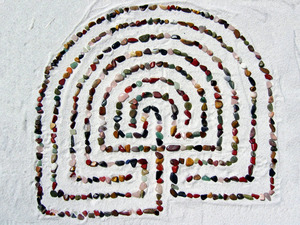Have you ever seen a labyrinth or had the chance to walk one for prayer or meditation? Many people think that mazes and labyrinths are one and the same. The difference is that a maze has many ways out and it is possible to become lost. A labyrinth, however, has only one path into the center and back out again.
Labyrinths were once used by Christians as a way to atone for sins and also for meditative prayer, much like using a rosary. Some ancient churches have labyrinths carved into the floors where worshippers can come and walk the line while they pray. There are a few different labyrinth designs, but all of them contain a single path which leads in a spiral pattern to the center and back out again.
Today, many people build their own labyrinths or visit a local park area where a labyrinth has been built in order to meditate. Walking the line of a labyrinth to its center and back out again is symbolic of taking a path inside your soul and back out again. It can offer insight and many people who use labyrinths claim that they are better able to solve problems while walking a labyrinth and that it works well for calming them or reducing stress in their life.
You can easily build your own labyrinth in your backyard. Not only will it be a useful tool for meditation and de-stressing, it makes a lovely focal point for your yard or garden, much like a statue or piece of art. Labyrinths are generally permanent, but like any garden, do require a small amount of care to keep them beautiful.
When building your labyrinth, mark it out first in either sand or with a long piece of brightly colored yarn. With a stone labyrinth, you can easily move the stones, so you may not need to mark out the boundaries first with sand or string. Always start drawing your labyrinth from the center and work your way out again. It is much too difficult to start from the outside and work your way in as you may run out of room before reaching what you intend to be the center.
Look online to research your labyrinth ideas. There is more than one way to draw your labyrinth and you can choose from simple designs as well as more complex types. Your labyrinth also does not need to be exactly like the photograph that you find. There is room for your own interpretation. If you are creative, you can even try different shapes such as hearts, crosses, or squares.
Stone Labyrinth
The easiest type of labyrinth to build is a stone labyrinth. You can use a variety of different stones from flat flagstones to small round boulders or river stones. Stone labyrinths can be easily moved, so you will likely not need to mark them out first with sand or string. Flat flagstones will make a path that can be trod upon. Larger round stones can be used to mark the boundaries of a path and you will be able to walk between them.
Grass Labyrinth
The next simplest type of labyrinth is a grass labyrinth. You can cut the design into the grass of your lawn and fill it with gravel or wood chips, or you can mark a path onto the ground where there is no grass and build mounds of grass-planted soil between the paths. As above, fill your path with gravel or wood chips to keep grass from growing onto the path and to keep it from getting muddy in rainy weather.
Hedge Labyrinth
One of the most difficult to build, and also most beautiful types of labyrinth, are hedge labyrinths. These can be costly and take quite some time to grow, but if you are an avid gardener, have a large lawn, and would like something amazing and fairly permanent, this may just be the project for you. A low hedge works best and will grow fastest. Plant your hedges between the walking paths far enough apart that you will be able to walk between them without scratching your legs against their branches.





